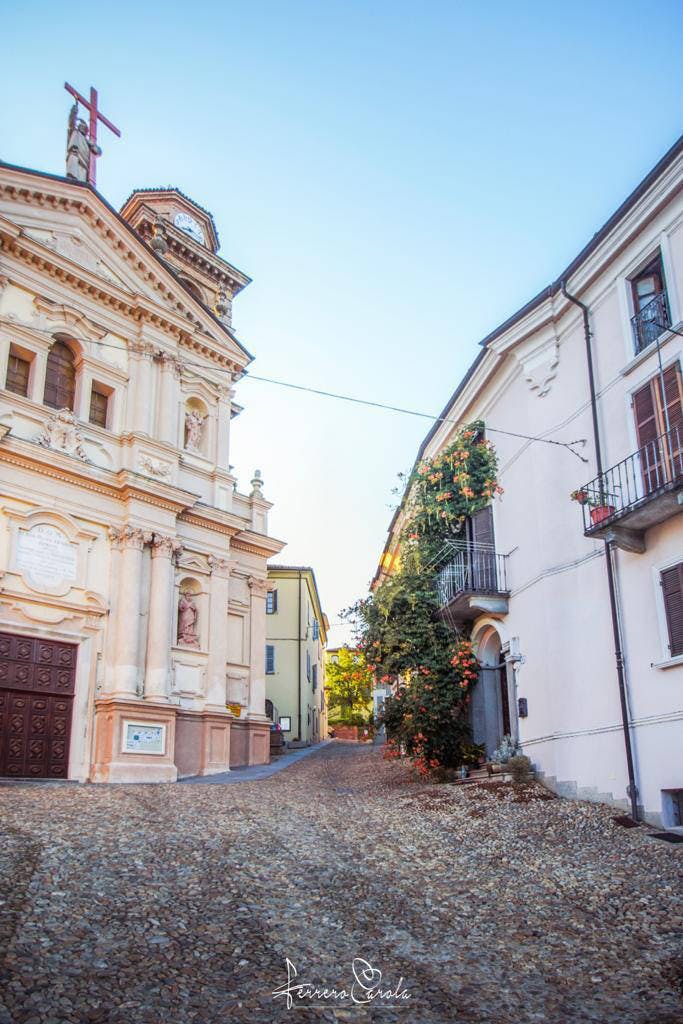Castagnole delle Lanze - The Parish Church of Saint Peter in Chains
The Piedmontese Baroque style
 The imposing mass of the Parish Church of Saint Peter in Chains dominates the town of Castagnole. Its erection began in 1681, with the demolition of previous church dedicated to Saint Mary. The construction works, due to the difficult situation in which the Duchy was at that time, ended only in 1701. The position of the church, situated over a small hill, contributes to make even more majestic its imposing façade, which was built around 1715 based on a design by royal architect Michelangelo Garove. Restored for the first time in 1779, the façade assumed its present form in 1904, after some modifications were applied to the original design.
The imposing mass of the Parish Church of Saint Peter in Chains dominates the town of Castagnole. Its erection began in 1681, with the demolition of previous church dedicated to Saint Mary. The construction works, due to the difficult situation in which the Duchy was at that time, ended only in 1701. The position of the church, situated over a small hill, contributes to make even more majestic its imposing façade, which was built around 1715 based on a design by royal architect Michelangelo Garove. Restored for the first time in 1779, the façade assumed its present form in 1904, after some modifications were applied to the original design.
The interior, consisting of a single nave with two orders of chapels, is sixteen meters in height, thirty-seven meters in length and ten in width. The entire internal surface is adorned by a rich pictorial decoration in Neo-baroque style, painted between 1924 and 1927 and by numerous stuccoes, mostly made during eighteenth century. The succession of the altars starts with the Major one, built in 1771 on commission by Counts Alfieri according to the testamentary provisions of Count Carlo Emanuele Alfieri. The altar is a notable example of the late Piedmontese Baroque, made of precious polychrome marble. The first two side altars, in front of the presbytery, are dedicated to the Immaculate Virgin and to Saint Anthony of Padua. Made of wood at the end of the seventeenth century, they are rich in carvings and gilding, especially that of Saint Anthony, the Paduan saint who in the middle of the seventeenth century was voted by the town as the heavenly patron of Castagnole. The same altar commemorates with a tombstone the fallen persons during First World War.
In the second order there is the altar of Saint Joseph, an excellent example of Piedmontese Baroque architecture of the early eighteenth century. In front of it, there’s the altar of the Sacred Heart, realized in marble in 1908, in substitution of an earlier one, dedicated to Saint Francis Xavier. In the last order, near the entrance door, is located the altar of Our Lady of the Graces. The center of the altarpiece preserves a precious fresco of '500, depicting the Virgin with the child. This image is linked to an ancient popular devotion that preserved from destruction the previous church which kept it. Important are also the frescoes that adorn the chapel, dating back to the early eighteenth century, brought back to light in 2006. Om the opposite side, the chapel is entirely occupied by the baptistery, built in 1946. The baptismal font is a significant example of sacral art of twentieth century, defined by a careful work of sculpture and eight types of precious marble.
The church also preserves important examples of 18th century Piedmontese cabinet-making. In the nave there are in fact two confessionals realized around the end of seventeenth century, surmounted by the pulpits of 1703; in particular the left one, once reserved for the archpriest, is decorated with panels carved with the symbols of the passion. Another important artifact is the choir, made of walnut wood, located behind the high altar, dating back to the early eighteenth century. The imposing layout of the structure is softened by carvings depicting the faces of cherubs with wings, which carry some fruits of the earth. Last important artifact is the precious large closet of the sacristy, built by Asti’s workers around 1775. Located on the tribune above main entrance is finally the organ, manufactured in 1896 by Vittino of Centallo artisan workshop, one of the most renowned pipe organ shops of that time.